Dolphin/Gestionarea fișierelor
Dolphin or Konqueror?
Dolphin is the file management application of Plasma Workspace. It is designed to be simple to use, yet powerful.
Konqueror was the default file manager in KDE 2 and 3, and is still available for those who prefer its interface. It is a web browser, a file manager, media viewer and more. For file management it uses the Dolphin KPart, and so has all of the functionality of Dolphin.
Descoperă Dolphin
Prima secțiune te va duce la un tur ghidat al Dolphin-ului.A doua secțiune se ocupă cu conceptele diferitelor tipuri de marcaje.A treia secțiune discută de gestionarea arhivei. În final ne uităm la 'More Cool Things'. Se poate da click pe imagini - poți vedea imaginea mărită.
Introducere către Dolphin
Dolphin este managerul de fișier al Compilației Software KDE.
Voi arăta cum se folosește Dolphin pentru sarcini comune de gestionare a fișierului, și cum să-l personalizați nevoilor dumneavoastră.
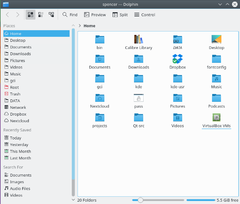
When we open the Dolphin from the Kickoff menu it shows your starting directory - by default it is your Home directory.
To open a file, or go to a folder just click on it. (This can be changed to double-click in → → or in → → for older versions of System Settings)
Pentru a selecta și deselecta fișiere și foldere ,plasați cursorul mouse-ului deasupra pictogramei și faceți click pe semnul plus în curs de dezvoltare pentru a selecta, și semnul minus pentru a deselecta.Cam asa:
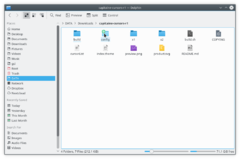
Când apăsați pe semnul plus, acest fișier sau folder va fi adăugat la selecția dumneavoastră.Puteți selecta fișiere multiple în același mod. Selecția se poate face de asemenea prin glisarea unui dreptunghi ( uneori numită metoda "bandei de cauciuc"), iar selectarea și deselectarea cu Ctrl + click pentru unul la un moment dat și Shift + click pentru un interval continuu.
Multe fișiere selectate arată așa:

Crearea unui nou folder : Puteți crea un nou folder în directorul activ folosind sau comanda rapidă F10.
Tabs: Dolphin supports tabbed browsing. A new tab can be opened for example from → (if you have enabled menu bar), by Ctrl + T or by middle mouse click on folder icon and navigation buttons.
Dolphin opens by default when we click on any folder. It can also be started from Kickoff menu.
The Interface
Location Bar
Dolphin integrates a new concept to use the location bar in a faster and more precise way: therefore a breadcrumb location bar is used. Instead of displaying the complete path only the navigation points starting from one of the places are displayed as buttons. By clicking one of these buttons you navigate directly to this folder. In this way you can reach a parent folder from a sub folder in a very quick way.
Între butoanele care reprezintă un folder există o mică săgeată care este de asemenea un buton.Făcând click pe această săgeată poți vedea o listă cu toate subdirectoarele pe același nivel ca cel actual al tău, oferindu-vă o schimbare rapidă de director.
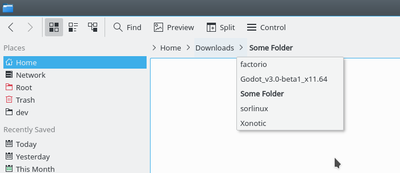
There is also a classical location bar which displays the complete path. To use this style you can right click on the Location Bar and select . If you want the Location bar to become editable, trigger the keyboard shortcut Ctrl + L or select → → . By clicking on the free space next to the last displayed folder in the breadcrumb style you can switch to an editable Location Bar as well. If the editable style is selected a checkmark is displayed at the end of the location bar. This checkmark is a button which can be used to change back to the breadcrumb style. Of course menu and keyboard shortcut can be used, too.
Split View
Dolphin offers the possibility to split the current folder view so that two folder views are displayed next to each other as known from Midnight Commander, or Krusader. This is a very comfortable view to copy or move files from one folder to another.
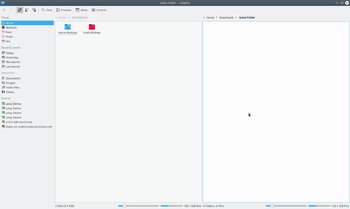
You can split the view by clicking on in the tool bar or, if you have enabled menu bar, (keyboard shortcut F3). To change back to only one folder view you can click on or just press F3 again. The symbol will show you which view will be closed. Depending on the currently active view the minus sign will be shown in the left or right part of the symbol. The active view will be closed. This is important to know if you want to use the keyboard shortcut. There is also a button for splitting and closing the view situated in the toolbar. This button displays the minus symbol as well, so it is easy to know which view would be closed.
Of course each view has its own location bar and each view can use a different view mode.
Sorting Files
By default, the files in the currently displayed folder are sorted in ascending alphabetical order. However, this can be changed by selecting → .
Files may be sorted by the following attributes
- Name
- Size
- Date
- Permissions
- Owner
- Group
- Type
- Link Destination
- Path
The sorting method can be changed by selecting → → , → → or → → .
View Mode
Dolphin features three different folder view modes:
 Icons shows each file or folder as an icon with its name
Icons shows each file or folder as an icon with its name
 Compact is the same as icons, but in a more compact form, allowing more folders and files to be displayed at once
Compact is the same as icons, but in a more compact form, allowing more folders and files to be displayed at once
 Details presents a list of files and folders, giving information on each, including but not limited to size and date
Details presents a list of files and folders, giving information on each, including but not limited to size and date
The mode can be changed from within Dolphin
- Select from the menu. This option is only available if the main Menubar is enabled
- Select from the menu. This option is only available when the main Menubar is disabled
- By selecting the appropriate icon from the main toolbar, if it is enabled
- Using the default keyboard shortcuts:
- Ctrl+1 switches to the Icon display mode,
- Ctrl+2 switches to Compact and,
- Ctrl+3 switches to Detailed view.
View as Icons
Each file and each folder is represented by an icon in this mode. Alternatively a preview, or of the file can be displayed. Instead of displaying an icon a preview of the file can be shown. This feature can be turned on/off via the menu → (if menu bar is enabled) or via the main toolbar button .
There is the possibility to display additional information below the icons. These can be turned on/off via → or → (if menu bar is enabled). In principal the same criteria which are available as search criteria can be selected.
You can group the icons to achieve a better overview. This is turned on via → or → (if menu bar is enabled). Now the icons are grouped and the groups are divided by a horizontal line containing the name of the group as caption. The grouping is related to the selected search criteria.
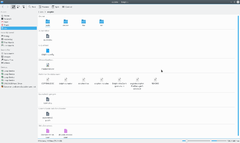
Detalii
În modul de vizionare "Details", informația suplimentară este afișată în mod implicit în contrast în modul de vizionare "Pictograme". Toate fișierele sunt listate într-un tabel.Meniul contextual din antetul tabelului oferă posibilitatea de a adăuga coloane suplimentare.Următoarele coloane sunt disponibile:
- Size
- Date
- Permissions
- Owner
- Group
- Type
- Link Destination
- Path
Column "Name" is always displayed. By clicking on the header of one of the columns the table will be sorted by this column. By clicking on the same column header the sorting sequence is reversed.
Since KDE 4.1 it is possible to display the folders as a tree. In this mode a plus sign is shown next to the folder. Plus sign has been replaced by > symbol in newer KDE versions. By clicking on this sign the folder is expanded and all containing sub folders and files are also shown in the table but they are attenuated. By clicking the sign, which displays a minus now (or an arrow pointing downwards in latest versions), again the expansion is closed again. Of course the tree structure can be used for as many folders as wished. In latest KDE releases, the tree view is enabled by default, but can be deactivated via → → → with option .
Coloane
View mode "Columns" was inspired by the file manager Finder of Mac OS X. Entering a sub folder did not replace the current folder view but the content of the sub folder was listed in an additional column next to the column of the parent folder. This could be used for several hierarchies, so that you could navigate in an easy and fast way in the file system. Since KDE 4.8, view mode "Columns" has been dropped and will not be available in future Dolphin releases.
Setting defaults for all folders
Under → (or under the menu item → if you have enabled menu bar) you can set any of these attributes to be the default for all folder views.
Panouri
Dolphin contains several panels, which can be activated via menu → . Each panel can be placed in the left or right docking area. To move a panel you have to unlock panels (right clik on a panel and select ), click on the header and Drag&Drop the panel. The area where the panel will be placed on mouse released is highlighted. It is possible to stack panels on top of each other. In this case the panels are placed into tabs.
În antetul fiecărui panou există două butoane. Butonul aproape de legendă detașează panoul. Acest lucru face ca panoul să fie o fereastră independentă care "plutește" deasupra Dolphin-ului. Fereastra este încă combinată cu Dolphin și nu poate fi afișată fără Dolphin și nu poate fi de exemplu minimizată ca ferestrele normale. Făcând din nou click pe buton, panoul este din nou andocat.Al doilea buton va închide panoul.
Dialoguri Non Modal
Atunci când se mută,copie sau sterg fișiere/directoare , dialogul dispare chiar și atunci când operația nu a fost încă finalizată. O bară de progres apare în partea din dreapta jos a ecranului,în cele din urmă aceasta dispare, dacă doriți să vedeți progresul trebuie să faceți click pe o mică pictogramă informațională (i) din tava de sistem.
Locuri
Dolphin contains a new kind of bookmarks Places. These are displayed in a panel which can be activated via → → (keyboard shortcut F9). The default Places are identical to the ones shown in the category Computer of the K-Menu Kickoff.
Făcând click pe unul din aceste locuri, va fi deschis în vizionarea curentă a folderului.Meniul contextual oferă posibilitatea de a edita locurile sau de a le elimina din nou.De asemenea este posibilă ascunderea temporară a înregistrărilor.
Meniul contextual al unui folder poate fi folosit pentru ai genera acelui folder o altă intrare la panoul Places. Prin urmare există un element de meniu . Poți de asemenea să tragi și să dai drumu unui folder în panoul Places.
De asemenea panoul de locuri conține intrări la dispozitive conectate detașabile precum tastele USB sau CD-uri.O pictogramă plug mică indică dacă dispozitivul este montat.Meniul contextual oferă posibilitatea de a demonta dispozitive.
Locurile sunt folosite ca bază în bara de navigare breadcrumb. Fiecare adresă este prezentată în legătură cu folder-ul părinte cel mai apropiat, care este unul din locuri.
Informații
The information panel can be activated via → → (keyboard shortcut F11). This panel displays a preview or an icon of the currently selected file/folder or of the file/folder below the mouse cursor. Some additional information like change date or size to the file/folder is displayed as well.
Panoul de informații oferă posibilitatea de a evalua fișiere, adăuga un comentariu sau de a eticheta un fișier. Aceasta este una dintre interfețele pentru semanticul Desktop Nepomuk care furnizează avantajele web-ului semantic pentru desktop. Pornind de la KDE 4.2 , este posibilă căutarea legăturilor semantice oferite de tag-uri.
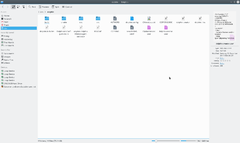
Foldere
A panel providing a tree structure for the file system can be displayed via → → (keyboard shortcut F7). The tree structure offers the possibility by clicking the > and ˇ signs to expand/collapse sub folders. By clicking on one of the folders the content will be displayed in the current view.
Terminal
The terminal emulator Konsole can be displayed directly in Dolphin via → → (keyboard shortcut F4). This makes it possible to use shell commands directly in Dolphin. The terminal is opened in the folder which is displayed in the current view. Shift + F4 opens Konsole in new window.
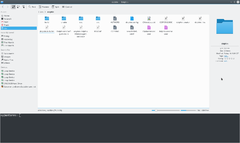
Marcaje și Locuri
În KDE3 ai putut crea marcaje în Konqueror dar nu erau disponibile pentru nici o aplicație. KDE SC 4.x oferă o afacere cu mai multă flexibilitate - dar asta inseamnă în mod inevitabil să te complici mai mult. De fapt, KDE SC 4 are trei categorii de Marcaje, care trebuie să fie diferențiate. Ele aparțin diferitelor fișiere și au diferite funcții.
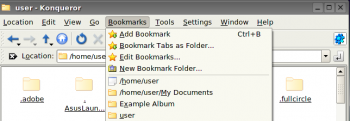
Trei tipuri de marcaj
First, there is the set of bookmarks available only to Konqueror - web bookmarks. These are stored in ~/.local/share/konqueror/bookmarks.xml. Then there is a set which Dolphin calls Places. This set is available to all applications as well as the Dolphin file manager. Every time you use → you will see this set. The third set of bookmarks are Application Bookmarks. These share one file, regardless of the application that set them, and are available to all applications, unless you restrain them to a specific application. More of that later.
Activarea Marcajelor
Bookmarks are not enabled in dialogs by default. To enable them
- Open the menu and select or
- Click the Options
 icon
icon - Select
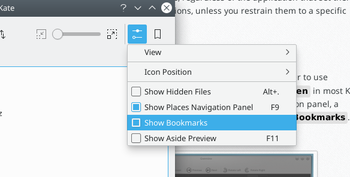
Există un set implicit de Places -
- Home
- Rețea
- Root
- Trash
dar puteți adăuga alte locuri. În Dolphin, faceți click dreapta pe un folder și selectați , sau pur și simplu glisați un folder în Places.
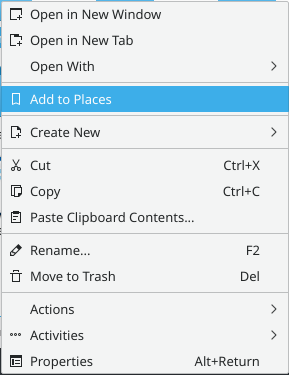
În mod implicit acest "Place" va fi visibil în toate aplicațiile. Dacă doriți să-l păstrați constrâns în Dolphin, trebuie să faceți click dreapta pe noul nume din lista Places, unde veți găsi opțiunea de a-l Edita. Există o casetă de verificare pentru .
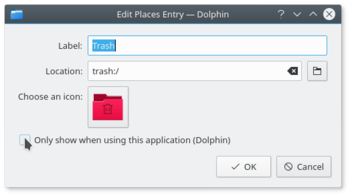
Puteți vedea rezultatul acelei comenzi dacă citiți ~/.kde4/share/apps/kfileplaces/bookmarks.xml.
În unele aplicații există o opțiune în meniul File pentru a adăuga un folder la Places. În acest stadiu aplicațiile variază în funcție de ce caracteristici sunt disponibile. Cel mai important lucru de reținut este că implicitul este pentru elementele Places pentru a fi diponibil tuturor aplicațiilor din dialogul .
Marcaje în aplicaţii
Aceasta este cea de a doua categorie a marcajelor. Vă amintiți cum să deschideți menuchoice>File -> Open</menuchoice> și să folosiți cheia de piulițte/cheia? Lângă ea se află o stea galbenă. Aceasta este meniul gestionării marcajelor.
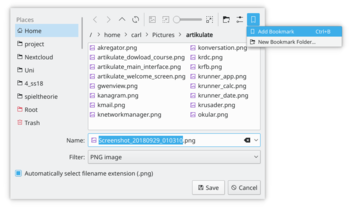
Here you can define bookmarks that will be visible in the same menu on any application. They are stored in one file, ~/.local/share/kfile/bookmarks.xml, which is used by all applications having that menu.
Constrângerea către o singură aplicație
Unele aplicații vă permit să editați elemente în meniul Places. De exemplu, dacă în Gwenview faceți click dreapta pe un folder în Places , puteți seta o opțiune la .
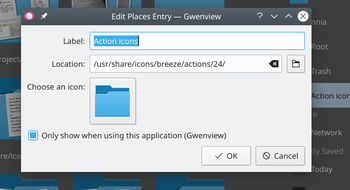
If you need to constrain to an application that does not yet allow you to do that, the only way left is to edit the file ~/.local/share/kfile/bookmarks.xml. Immediately before the </metadata> tag you will need to add the line
<OnlyInApp>appname</OnlyInApp>
Gestionarea Arhivelor în Dolphin
Gestionând arhive devine o treabă simplă. În orice director în Dolphin, evidențiați fișierele pe care doriți să le comprimați, și faceți click dreapta. Aici, folosind opțiunea Compress, puteți selecta să creați o arhivă RAR, o arhivă tar Gzipped, sau să definiți un alt mod de compresie pe care deja l-ați setat.
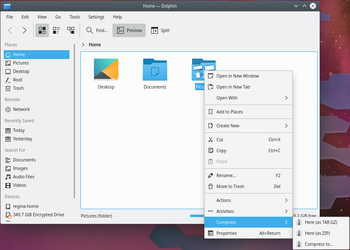
În mod similar, dacă faceți click dreapta pe fișierul arhivă deja existent , opțineți o serie de acțiuni adăugate în meniul click dreapta. Puteți extrage arhiva în folder-ul curent, la un subfolder autodetectat sau într-un alt loc la alegerea dumneavoastră.
Dacă doriți să adăugați fișiere la o arhivă existentă, puteți folosi .
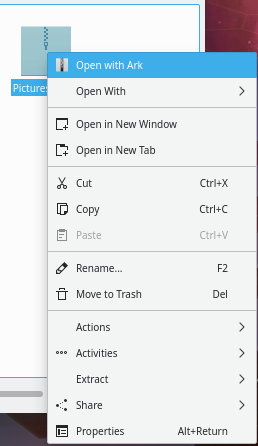
Mai Multe Acțiuni Cool
Change a File Association on-the-fly
Have you ever wanted to open a file, only to find that it is associated with an application that is not of your choice?
You can, for one, alter this in → → → → . This is the same as running kcmshell5 filetypes in a Konsole.
Alternatively, if you want to change multiple associations right quick, you would edit the *.desktop file directly, e.g. the file /usr/share/applications/org.gnome.Builder.desktop. For example, Gnome Builder associates with a great number of file-types which may not be desirable. So the line
MimeType=application/javascript; # we do not want all of these ....
may be shortened or commented out with # . Maybe a line
InitialPreference=2 X-KDE-InitialPreference=3
in the builder.desktop file helps to keep your previous default associated app, with builder being only secondary or tertiary option.
Thirdly, Dolphin and Konqueror offer a quick method for changing a single association:
Right-click on the file and select . The first line there is descriptive, something like:
Type: XML document
La același nivel, la dreapta, există o cheie. Faceți click pe ea și veți putea adăuga sau schimba o asociere.
În mod similar, lucrând într-un folder, puteți schimba managerul implicit de fișier la/de la Konqueror, dacă alegeți, sau să adăugați o altă imagine browser la asocierile posibile.
Submeniul Actions
The sub-menu opens up a whole lot more cool things to do from Dolphin. Some possibilities only appear when applicable to the file you have selected. An apps .desktop file below /usr/share/applications defines what actions are applicable for a particular type of file. Some of the options are
- Convert an image file to a different format
- Preview the file
- Download a remote file with KGet
- Sign and/or encrypt the file, according to the encryption software installed
Codifică și copie piese CD audio
- Introduceţi un CD audio
- Navigați la acest CD în Dolphin: trebuie să apară ca "Volume" în Dolphin 'Places' sau puteți ajunge la el tastând audiocd:/ în bara de adresă.
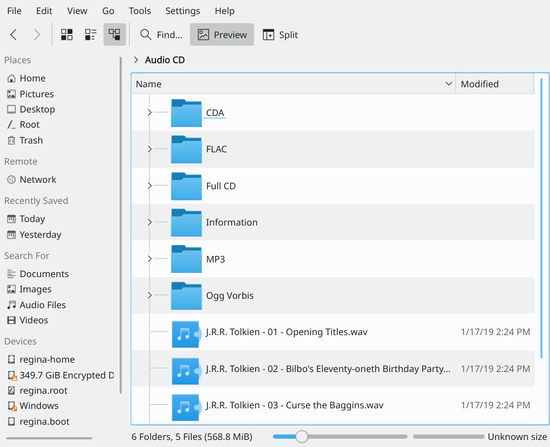
Acum observi că 'Dolphin propune un fișier WAV pentru fiecare piesă,plus:
- un folder CDA care conține informații de indexare în formatul obișnuit CDA.
- un întreg folder CD, care conține câte un fișier pentru fiecare format (.cda, .flac, .mp3, .ogg, .wav) deținând toate piesele
- un folder FLAC, care conține piesele codate în format FLAC (format fără pierderi de informaţii)
- un folder informativ care conține informațiile CDDB
- un folder MP3, care conține toate piesele în format MP3
- un folder Ogg Vorbis, care conține piesele codate în format OGG
Apoi trebuie doar să copii folder-ul la alegere, în formatul tău preferat pentru a opține versiunea relativ codificată a CD-ului tău!
timeline:/ and have your recent files as startup folder
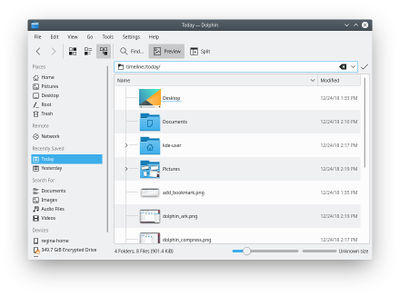
In a current (2017, Version 16.08.3 of) dolphin (with baloo up and running), you can start up dolphin with a view of recently modified files: Just navigate to the address/location of timeline:/today/ (copy paste it to the address bar) or use it as dolphin start-up-folder in dolphin-settings. With older versions of dolphin, this required the below manual steps:
Dolphin has access to a large number of file transfer protocols (KIO Slaves). One of those is provided by the KDE semantic search system (Nepomuk). Nepomuk offers a transfer protocol named history. You can navigate to it by entering timeline:/ in the location bar.
One particularly neat thing there is the ability to have the Today folder from the timeline:/ protocol in the Places sidebar (you can just drag it there!). You can then change the name and icon (do a right click on the new Today entry and choose ).
It could be very useful to have this view of recently used files immediately when you start Dolphin. Unfortunately, as of Dolphin 2.1 (part of KDE SC 4.9) this is not possible without editing the Dolphin configuration file. See this blog for more details on that.
To edit the configuration file, first close all Dolphin windows. Dolphin will save its configuration upon closing, overwriting any changes you might make!
Then use KRunner (Alt + F2) to edit ~/.config/dolphinrc with KWrite as follows: kwrite ~/.config/dolphinrc. You can of course use any other editor as well, like Kate. In the configuration file, locate the [General] section to edit the HomeUrl into: HomeUrl=timeline:/today and save the file. You should now have the today view as default and have the files you're most often looking for at your fingertips!



